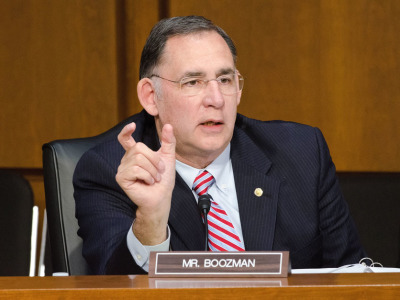Since COVID-19 disrupted the meat supply chain in the spring, there has been a growing consensus between Republicans and Democrats on Capitol Hill that the meat processing industry needs more competition, but that comes with a few barriers.
The spread of the virus exposed weaknesses in the meat supply chain, which led to plant shutdowns, price margin differences between the producer and packer, and more consumers buying from a local butcher to ensure they wouldn't be faced with empty shelves at the grocery store.
House Agriculture Committee Chair Collin Peterson, D-Minn., recently said consumers are likely to face higher costs if the current structure — which emphasizes a smaller number of larger facilities — is maintained.
“I don’t think like in the case of hogs, they’re going to be able to run as tight of ship as they did,” he said at Monday's Agri-Pulse Ag and Food Policy Summit. “The end result out of these plants are going to be higher prices because we’re going to have costs if you slow all this stuff down.”
What's more, Peterson sees this as an issue that will need to be addressed on Capitol Hill, dismissing potential action from the Justice Department that might infuse competition in the sector as "a pipe dream."
“To think that the Justice Department is going to fix this. … I’ve got some swampland in Arizona if you want to buy it,” Peterson quipped.
One way Peterson thinks he could help plants is through legislation establishing a program to provide grants to existing meat and poultry processors to upgrade their facilities. Peterson argued this bill, introduced in July with former committee Chair Frank Lucas, R-Okla., and a handful of other committee members, would help processors move to federal inspection and be able to sell their products across state lines.
“We don’t need a plant that’s going to have 20,000 head a day killed. We need some 1,000-2,000 head a day plants and we need them spread out geographically,” Peterson said. He also noted the smaller plants need federal inspectors so they can sell their products nationwide.

House Ag Committee Chair Collin Peterson, D-Minn.
Other legislation introduced since the onset of the coronavirus would make it easier for certain state-inspected facilities to sell their products across state lines, which is currently prohibited by federal law.
Rep. Mike Conaway, R-Texas, the committee's top Republican, told Agri-Pulse he sees a movement toward smaller processors, but cautioned about the need to protect foreign perception of the U.S. processing sector.
“What we don’t want to do as we look at that is somehow create any kind of a food safety issue or perception of a food safety issue with our trading partners around the world,” Conaway said.
He stated USDA is the “gold standard” for food safety around the world, and the U.S. relies on that reputation to facilitate trade agreements around the globe.
After Congress has already spent trillions to mitigate the impact of the coronavirus pandemic, Conaway noted it is going to be hard for money to flow to processors instead of producers.
In a 2019 report, Iowa State University economist Lee Schulz said there had been little change in the split of the nation's beef processing capacity since the turn of the century.
“In 2018, packing plants that slaughtered between 1 and 9,999 head slaughtered 427,300 head, or 1.3% of the (federally inspected) cattle slaughter,” Schulz wrote. He said the number is 3.5% for plants slaughtering between 10,000 and 99,999 head annually and 38.7% for plants slaughtering between 100,000 and 999,999 head annually.
Schulz said that compares to 1.5%, 4.4%, and 38% recorded in 1999.
John Boozman of Arkansas, a leading Republican on the Senate Agriculture Committee, said he wants to make it easier for smaller packers to get into the business without sacrificing food safety.
“I think we can do that and just get some more competition, and in doing so, get a great product out on the market and make it such that we improve the price of cattle,” Boozman, widely considered to be the leading candidate to be the top Republican on the Senate Ag committee following the retirement of Sen. Pat Roberts, R-Kan., told Agri-Pulse.
Boozman said as he travels his state, he hears from producers that local processors are booked to process livestock through most of next year. That, he said, could serve as evidence of a need for more processors to come online.

Sen. John Boozman, R-Ark.
He said he would be open to exploring a cost-share type of program to help smaller processors pay for federal inspectors, but Conaway pointed out a caveat that if too many inspectors are hired to monitor newer smaller plants, it could become a waiting game.
“You don’t want an inspector just sitting around for a processor to call and say, ‘hey come over today, I want to process beef for retail today,’” Conaway said.
Established in the Federal Meat Inspection Act, any meat sold for public consumption must be federally inspected. Federal inspection personnel must be present “at all times during livestock slaughter operations and for at least part of each shift” when there is further processing of meat products, according to USDA.
Many see a shift to more, smaller facilities as — among other things — a form of risk mitigation within the industry; as observed earlier this year, shutting down a small number of massive facilities can cripple an industry's capacity. If that processing is distributed more broadly, more capacity may be able to stay online in the event of a singular plant shutdown due to a health crisis or facility damage such as what was observed after a fire at a Holcomb, Kan., facility in 2019.
But spreading out the production isn't without its issues.
According to Glynn Tonsor, an economist at Kansas State University, small processors faced challenges finding a market for products before the coronavirus pandemic.
Interested in more coverage and insights? Receive a free month of Agri-Pulse.
“For instance, consider tongues, roasts, etc. — those products can be harder to sell than steaks and ground beef," he told Agri-Pulse in an email. "Larger facilities have economies of scale (in part allowing better access to export markets) that help with that and other things.”
While there is a trend in consumers buying from smaller processors, Derrell Peel, an agricultural economist at Oklahoma State University, told Agri-Pulse having capital is a big issue.
“A fairly small plant is relatively expensive to build given the potential size of the business there,” he said. Also, finding enough workers and inspectors for a plant are other concerns.
Even if there is an increase in small processors over the next several years, Peel said these smaller facilities may offer some good opportunities for producers, as well as consumers, to have access to more products, but added it won’t necessarily make that big of a change.
“In the grand scheme of things, we’re not talking about the kind of volume (of production) that really changes the overall meat market picture,” Peel said.
However, given the fluctuations in the size of the nation's beef cattle herd, Peel suspects there may not be enough cattle to serve even the bigger plants, let alone potential new facilities.
For more news, go to www.Agri-Pulse.com.


